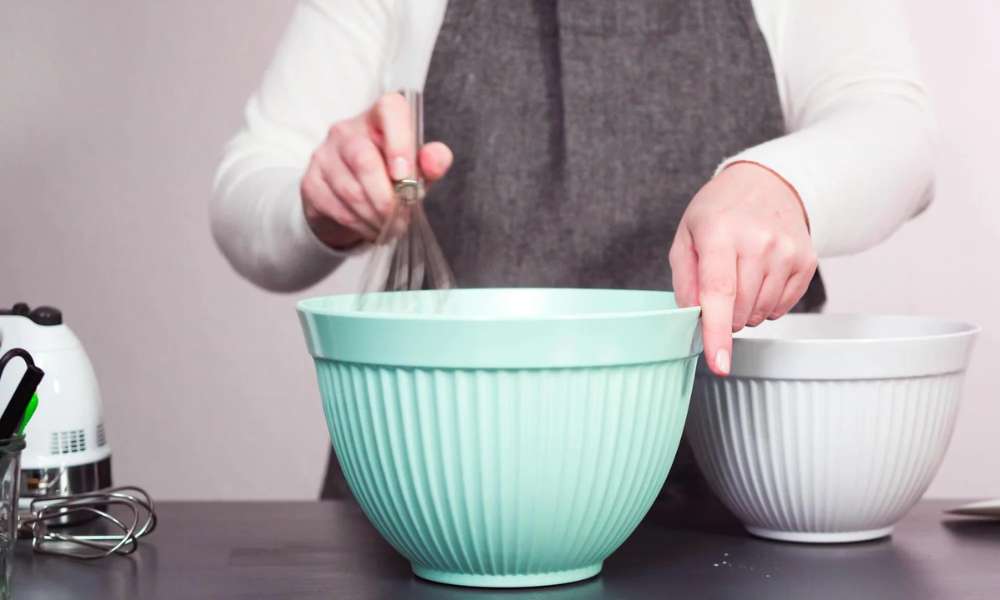Choosing the right material for mixing bowls depends on your needs and preferences. Stainless steel bowls are valued for their durability and versatility, perfect for both professional and home kitchens. They’re light, don’t rust, and won’t hold onto food smells or colors, but they’re noisy and not microwave-safe. Glass bowls are microwave and oven-safe, allowing you to heat ingredients directly. They’re good for watching your mix and don’t retain smells or stains, but they’re heavy and can break easily. Plastic bowls are light, cheap, and often microwave-safe, but they might take on stains and smells over time and can warp with heat. Each material has its pros and cons, so the best choice depends on what’s more important to you: durability, versatility, or convenience for your cooking and baking needs.
Stainless Steel Mixing Bowls
Stainless steel mixing bowls are renowned for their robustness and longevity, making them an excellent investment for both professional chefs and home cooks. Not only do they resist dents and scratches, but their non-porous nature means they are impermeable to bacteria and odors, ensuring a hygienic environment for food preparation. These are ideal for recipes requiring a cold touch. Their material can quickly adapt to temperature changes, making them perfect for whipping cream or tempering chocolate. Their reflective surface also aids in achieving a more thorough mix, as it makes it easier to spot unmixed ingredients. However, it’s important to note that stainless steel is not suitable for use in microwaves, which could be a limitation for some users.
Glass Mixing Bowls
Glass mixing bowls offer an aesthetically appealing option that combines functionality with beauty. Their transparency is not only pleasing to the eye. But allows cooks to easily monitor the progress of their mixes, ensuring that all ingredients are fully incorporated. This can be particularly useful for delicate tasks such as melting chocolate or tempering eggs. Where precise control over the mixture’s consistency is crucial. Additionally, glass is safe for use in both the microwave and the oven, providing versatility in the kitchen. They can withstand high temperatures without warping, making them ideal for recipes that require heating or melting ingredients directly in the bowl. However, the primary drawback of glass is its fragility. They are prone to shattering if dropped, which can be a safety concern in a busy kitchen.
Plastic Mixing Bowls
They are praised for their exceptional versatility and practicality in the kitchen. Available in a wide array of colors and sizes, these lightweight bowls are often the go-to choice for casual cooking and baking endeavors. Their durability makes them resistant to breaking or chipping, offering a safer alternative for families with young children. Many plastic bowls come with lids, providing an easy solution for storing leftovers or transporting dishes. Additionally, some are designed to be microwave-safe, making them convenient for reheating food directly in the bowl. However, it’s crucial to be mindful of the quality of plastic bowls, as some may absorb odors and stains from strongly flavored foods over time.
Ceramic Mixing Bowls
It brings a touch of elegance and tradition to the kitchen. Their heavyweight nature provides stability during rigorous mixing tasks, reducing the likelihood of the bowl moving around on the countertop. Ceramic bowls often feature beautiful designs and finishes, making them not only practical for mixing ingredients but also ideal for serving dishes at the table. They are heat-resistant and suitable for use in both microwaves and ovens, which adds to their versatility. However, similar to glass, ceramic bowls are prone to cracking or breaking if mishandled. Additionally, due to their porous material, they can absorb flavors and odors if not properly glazed.
Handle and Store with Care
Regardless of the material, always carefully handle and store to prevent damage. For glass and ceramic bowls, consider placing a layer of cushioning material, such as a towel or rubber mat. In your storage cupboard to mitigate the risk of accidental chips or cracks during retrieval. For stacking purposes, plastic and stainless steel bowls are designed to nest within each other conveniently, saving space and ensuring easy access. However, avoid stacking glass or ceramic bowls too high, as the weight could increase the risk of breakage.
Prevent Scratches, Stains, and Odors
To reduce the chances of scratches, stains, and odors, regular and mindful cleaning is crucial. Stainless steel bowls should be washed with warm, soapy water and can be dried with a towel to prevent water spots. Plastic, while resistant to breaking, can hold onto odors and colors from food. So it’s essential to wash them promptly after use, especially if they contain ingredients with strong odors or colors. Glass and ceramic benefit from a gentle cleanser and should be hand-dried to avoid water spots or streaks. Additionally, using baking soda as a gentle abrasive can help remove stubborn stains without scratching the surface. Avoid using sharp utensils directly to maintain their integrity and appearance for as long as possible.
Conclusion
Choosing the right mixing bowl is more than a matter of personal preference—it’s an investment in the functionality and efficiency of your kitchen. Stainless steel, glass, plastic, and ceramic bowls each offer unique benefits that can enhance your cooking and baking experiences. When selecting your next set, consider not only their aesthetic appeal but also how their material, and durability. And ease of maintenance aligns with your cooking habits and kitchen environment. By making an informed choice, you ensure that bowls will be valued companions in your culinary adventures, capable of withstanding the test of time and the heat of the kitchen. Whichever material you choose, remember that the best mixing bowl is one that meets your specific needs, encouraging your passion for cooking and baking with every use.

